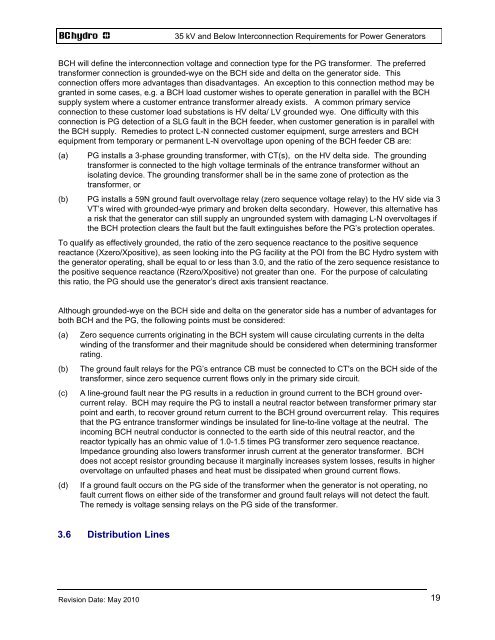35 kV and Below INTERCONNECTION REQUIREMENTS - BC Hydro
35 kV and Below INTERCONNECTION REQUIREMENTS - BC Hydro
35 kV and Below INTERCONNECTION REQUIREMENTS - BC Hydro
You also want an ePaper? Increase the reach of your titles
YUMPU automatically turns print PDFs into web optimized ePapers that Google loves.
Revision Date: May 2010<br />
<strong>35</strong> <strong>kV</strong> <strong>and</strong> <strong>Below</strong> Interconnection Requirements for Power Generators<br />
<strong>BC</strong>H will define the interconnection voltage <strong>and</strong> connection type for the PG transformer. The preferred<br />
transformer connection is grounded-wye on the <strong>BC</strong>H side <strong>and</strong> delta on the generator side. This<br />
connection offers more advantages than disadvantages. An exception to this connection method may be<br />
granted in some cases, e.g. a <strong>BC</strong>H load customer wishes to operate generation in parallel with the <strong>BC</strong>H<br />
supply system where a customer entrance transformer already exists. A common primary service<br />
connection to these customer load substations is HV delta/ LV grounded wye. One difficulty with this<br />
connection is PG detection of a SLG fault in the <strong>BC</strong>H feeder, when customer generation is in parallel with<br />
the <strong>BC</strong>H supply. Remedies to protect L-N connected customer equipment, surge arresters <strong>and</strong> <strong>BC</strong>H<br />
equipment from temporary or permanent L-N overvoltage upon opening of the <strong>BC</strong>H feeder CB are:<br />
(a) PG installs a 3-phase grounding transformer, with CT(s), on the HV delta side. The grounding<br />
transformer is connected to the high voltage terminals of the entrance transformer without an<br />
isolating device. The grounding transformer shall be in the same zone of protection as the<br />
transformer, or<br />
(b) PG installs a 59N ground fault overvoltage relay (zero sequence voltage relay) to the HV side via 3<br />
VT’s wired with grounded-wye primary <strong>and</strong> broken delta secondary. However, this alternative has<br />
a risk that the generator can still supply an ungrounded system with damaging L-N overvoltages if<br />
the <strong>BC</strong>H protection clears the fault but the fault extinguishes before the PG’s protection operates.<br />
To qualify as effectively grounded, the ratio of the zero sequence reactance to the positive sequence<br />
reactance (Xzero/Xpositive), as seen looking into the PG facility at the POI from the <strong>BC</strong> <strong>Hydro</strong> system with<br />
the generator operating, shall be equal to or less than 3.0, <strong>and</strong> the ratio of the zero sequence resistance to<br />
the positive sequence reactance (Rzero/Xpositive) not greater than one. For the purpose of calculating<br />
this ratio, the PG should use the generator’s direct axis transient reactance.<br />
Although grounded-wye on the <strong>BC</strong>H side <strong>and</strong> delta on the generator side has a number of advantages for<br />
both <strong>BC</strong>H <strong>and</strong> the PG, the following points must be considered:<br />
(a) Zero sequence currents originating in the <strong>BC</strong>H system will cause circulating currents in the delta<br />
winding of the transformer <strong>and</strong> their magnitude should be considered when determining transformer<br />
rating.<br />
(b) The ground fault relays for the PG’s entrance CB must be connected to CT's on the <strong>BC</strong>H side of the<br />
transformer, since zero sequence current flows only in the primary side circuit.<br />
(c) A line-ground fault near the PG results in a reduction in ground current to the <strong>BC</strong>H ground overcurrent<br />
relay. <strong>BC</strong>H may require the PG to install a neutral reactor between transformer primary star<br />
point <strong>and</strong> earth, to recover ground return current to the <strong>BC</strong>H ground overcurrent relay. This requires<br />
that the PG entrance transformer windings be insulated for line-to-line voltage at the neutral. The<br />
incoming <strong>BC</strong>H neutral conductor is connected to the earth side of this neutral reactor, <strong>and</strong> the<br />
reactor typically has an ohmic value of 1.0-1.5 times PG transformer zero sequence reactance.<br />
Impedance grounding also lowers transformer inrush current at the generator transformer. <strong>BC</strong>H<br />
does not accept resistor grounding because it marginally increases system losses, results in higher<br />
overvoltage on unfaulted phases <strong>and</strong> heat must be dissipated when ground current flows.<br />
(d) If a ground fault occurs on the PG side of the transformer when the generator is not operating, no<br />
fault current flows on either side of the transformer <strong>and</strong> ground fault relays will not detect the fault.<br />
The remedy is voltage sensing relays on the PG side of the transformer.<br />
3.6 Distribution Lines<br />
19
















